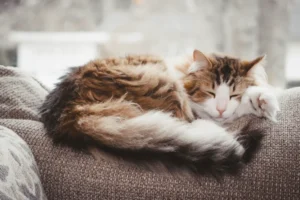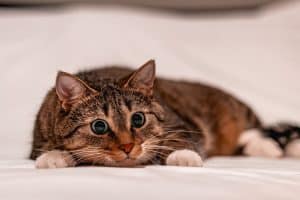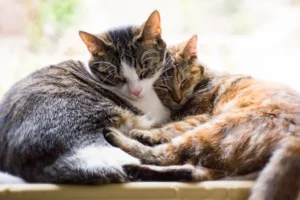Cats are known for their quirky behavior, from knocking things off shelves to running around the house like they’re on a mission. But have you ever noticed that when cats run, they often do so diagonally? It’s a puzzling behavior that many cat owners have observed but may not fully understand.
Cats run diagonally due to their natural hunting instincts.
Understanding Cats’ Hunting Behavior
Cats running diagonally is a behavior deeply rooted in their hunting instincts. Cats are natural-born hunters, and this behavior is a throwback to their ancestors who relied on stealth and strategy to capture prey. When cats run diagonally, they are actually mimicking the movements they would make while stalking prey in the wild.
Additionally, running diagonally allows cats to cover more ground quickly. This diagonal movement pattern effectively combines speed with agility, giving them an advantage when chasing down prey or engaging in playful activities. So, next time you see your cat darting across the room at an angle, remember that it’s all part of their innate hunting behavior.
The Role of Genetics
Genetics play a significant role in influencing a cat’s behavior and movement patterns, including their tendency to run diagonally. Certain genetic traits can predispose cats to exhibit specific behaviors, such as the diagonal running pattern commonly seen in many feline companions.
Moreover, genetics can also determine a cat’s overall agility and athleticism, which can influence their running style. Some cats may have a genetic predisposition to be more agile and quick on their feet, leading them to adopt the diagonal running technique as a natural way to move efficiently.
In addition to genetics, a cat’s environment and upbringing can also shape their behavior, so a combination of nature and nurture influences how and why cats run diagonally. Understanding the genetic factors at play can provide valuable insights into the unique behaviors of our feline friends.
Domestication and Behavior Changes
Through centuries of domestication, cats have undergone significant changes in their behavior, including how they display hunting instincts. This transformation has influenced why cats may exhibit diagonal running tendencies. Domesticated cats often engage in play behavior that mimics hunting, such as running in diagonal patterns. This behavior is believed to stem from their ancestral instinct to stalk prey at an angle, a technique that wild cats also use.
Furthermore, domestication has led to cats relying more on play and interaction with humans for stimulation. Running diagonally may simply be an expression of their playful nature, as well as a way for them to release pent-up energy. So, the next time you see your cat darting across the room in a diagonal frenzy, know that it’s just their way of channeling their inner hunter and having some fun!
Observing Cats in the Wild
When you look at wild cats in their natural habitats, you’ll notice that they too exhibit diagonal running behavior. This phenomenon is closely tied to their hunting tactics and survival instincts. Wild cats, like lions and cheetahs, often approach their prey at an angle to increase their chances of catching it. The diagonal run allows them to maintain balance, achieve greater speed, and make sudden changes in direction during the chase.
In the wild, diagonal running is not just a playful gesture but a strategic move that helps cats secure their next meal. It showcases their agility, precision, and adaptability in a competitive environment where every hunt could mean the difference between survival and starvation. So, the next time you witness a domestic cat running diagonally, remember that it’s a behavior deeply rooted in their ancestry and essential for their survival instincts.
Key Insight: Research shows that diagonal running in cats may also serve as a way for them to engage multiple muscle groups simultaneously, enhancing their physical fitness and coordination.
Interactive Play and Diagonal Running
When engaging in interactive play with your feline friend, you might notice them running diagonally with excitement. This behavior stems from their innate hunting instincts. Cats are natural predators, and the diagonal movement mimics the way they stalk and pounce on their prey. By incorporating toys that trigger these instincts, such as feather wands or laser pointers, you can encourage your cat to exhibit this diagonal running behavior more often.
Indoor vs. Outdoor Cats
The environment plays a significant role in a cat’s diagonal running behavior. Indoor cats may not have the same opportunities to hunt for prey as outdoor cats, leading them to channel their hunting instincts through interactive play. On the other hand, outdoor cats have more opportunities to engage in actual hunting, which can affect how often they exhibit diagonal running behavior. Providing indoor cats with interactive toys that simulate hunting can help satisfy their natural instincts and encourage them to run diagonally as if chasing prey.
Additional Insight: Indoor cats may be more prone to diagonal running behavior as a form of exercise and mental stimulation due to limited access to the outdoors.
Remember, interactive play is essential for all cats, whether they are indoor or outdoor. It not only helps keep them physically active but also stimulates their minds, fulfilling their innate need to hunt. By understanding the influence of their environment on their behavior, you can better appreciate why cats run diagonally and find ways to engage them in play that satisfies their natural instincts.
Tips for Encouraging Natural Behaviors
Cats are natural hunters, and their diagonal running behavior is a reflection of their predatory instincts. To encourage this natural behavior in your feline friend, you can try incorporating interactive toys that mimic prey movement. Toys like feather wands or laser pointers can stimulate your cat’s hunting instincts and encourage them to run and pounce diagonally.
Another way to support your cat’s natural behaviors is by providing ample opportunities for exercise and play. Setting aside dedicated playtime each day can help keep your cat active and engaged, reducing the likelihood of them engaging in destructive behaviors out of boredom. Creating a stimulating environment with climbing structures and hiding spots can also encourage your cat to run and play in diagonal patterns.
Remember, every cat is unique, so it may take some trial and error to find the toys and activities that best suit your feline companion. Pay attention to their preferences and adjust your interactive playtime accordingly to keep them engaged and active.
Pro Tip: Consider creating DIY puzzle feeders or hiding treats around the house to stimulate your cat’s natural hunting instincts and encourage them to run diagonally while searching for their next meal.
Fun Facts About Cats’ Running Behavior
Did you know that cats have a unique running style known as the “prey run”? When hunting or engaging in play, cats often exhibit this distinctive diagonal running pattern, which allows them to change direction quickly and efficiently. This behavior is deeply rooted in their evolutionary history as solitary predators.
Another fascinating fact is that cats can reach impressive speeds of up to 30 miles per hour in short bursts! Their agile and nimble movements, coupled with their diagonal running style, make them skilled hunters in the wild.
Fun Fact: Cats have a superb sense of balance and coordination, which is why they can effortlessly navigate obstacles and corners while running diagonally. This graceful movement is a testament to their agility and innate hunting prowess.
For more information on understanding your cat’s behavior, you can check out this helpful resource from the American Association of Feline Practitioners: Understanding Feline Behavior
Alex, a passionate animal lover, has experience in training and understanding animal behavior. As a proud pet parent to two dogs and three cats, he founded AnimalReport.net to share insights from animal experts and expand his knowledge of the animal kingdom.









